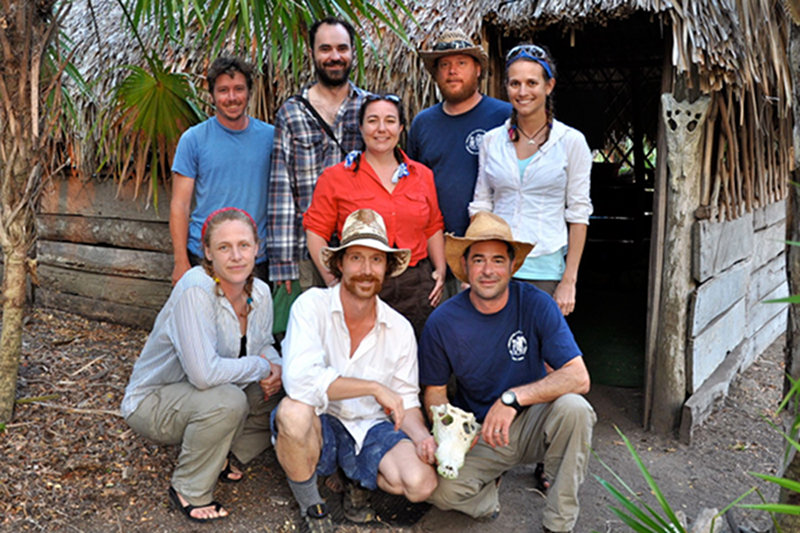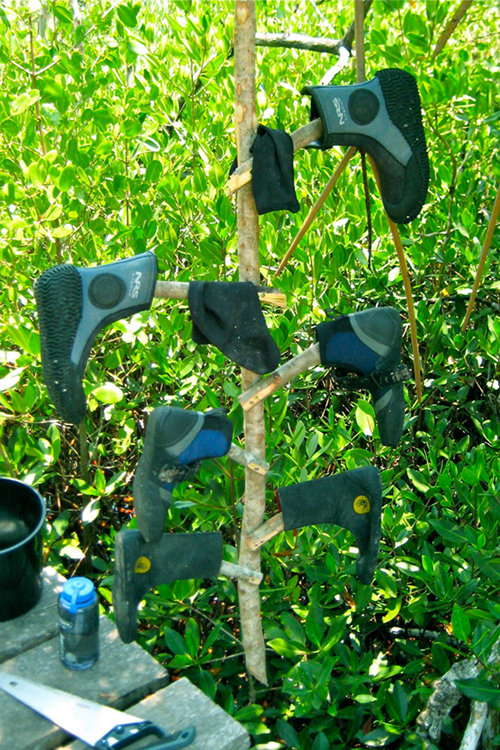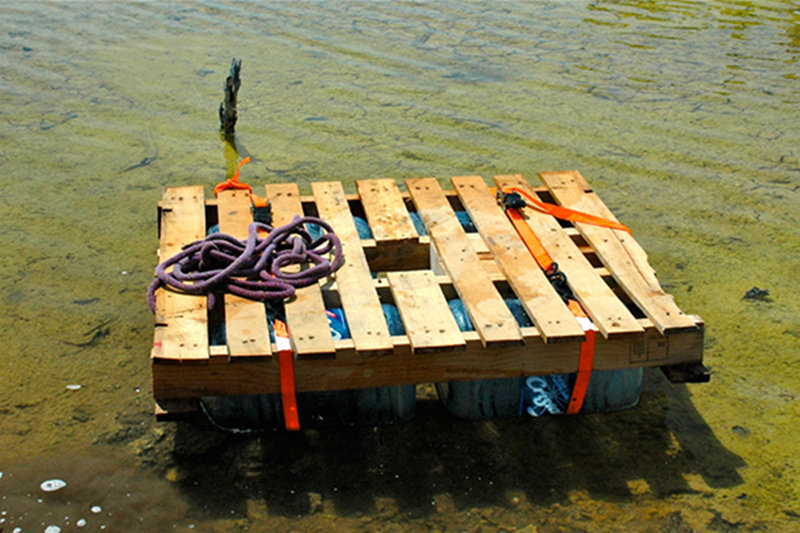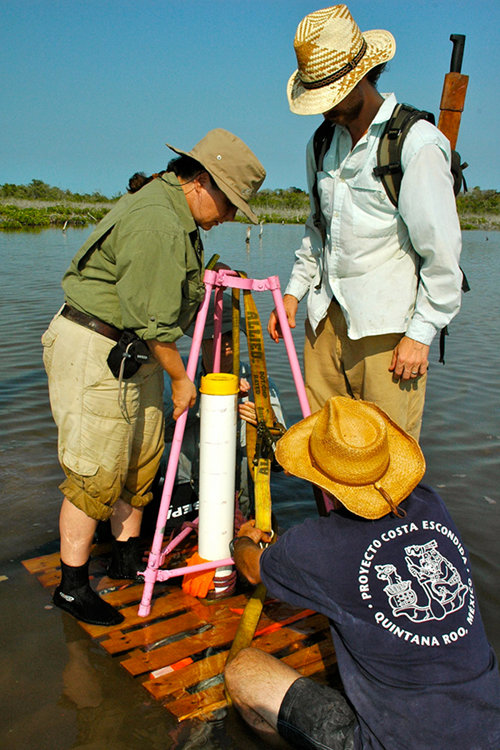
By Jeffrey B. Glover, PhD, Assistant Professor, Department of Anthropology - Georgia State University
September 26, 2011

Derek Smith and Dominique Rissolo put the final touches on the coring platform, constructed using 2 x 4s and two derelict dingys found in Chinquila. Image courtesy of Proyecto Costa Escondida Maritime Maya 2011 Expedition, NOAA-OER. Download larger version (jpg, 3.3 MB).
MacGyver (mek’gi’vur)
n. Star of 1980’s and 1990’s television show of the same name (actor Richard Dean Anderson) who was most well known for his ability to extricate himself from deadly situations with the most mundane of materials (i.e. map + duct tape to patch hole in hot air balloon, paper clip to disarm a missile or hot wire car).
v.i. [MACGYVERING < MacGyver show] to be resourceful, to overcome a problem with limited resources. “Nice MacGyvering, I wasn’t sure how we were going to get that toilet seat attached with just some parachute cord and a few screws.”
When asked to discuss the MacGyvering that has gone on during the field season, I at first chuckled – I mean, the show and the term are both a little ridiculous. While the term is funny, the necessity for resourcefulness in the field is anything but. This is not just true of archaeology but any field science, as was evidenced once this interdisciplinary team got into camp. Each member has done some MacGyvering that not only resulted in amusing anecdotes but, more importantly, in the successful completion of our expedition.

The Maritime Maya expedition team at Vista Alegre in front of the site’s main Palapa, from L-R (kneeling) Dr. Beverly Goodman, Dr. Jeffrey Glover, Dr. Dominique Rissolo, (standing) Dan Leonard, Wes Patterson, Dr. Trish Beddows, Derek Smith and Emily McDonald. While the team faced perhaps less than ideal working conditions, they were easily able to adapt and use ingenuity to make the project a success! Image courtesy of Proyecto Costa Escondida Maritime Maya 2011 Expedition, NOAA-OER. Download larger version (jpg, 1.5 MB).
At Vista Alegre we are not close to any modern amenities, which means we have to be fairly self-sufficient, and over the course of the expedition, resourcefulness and flexibility are key characteristics needed on a daily basis by all team members. While there were no bombs to disarm or hot air balloons to repair, the diverse situations where MacGyvering occurred “saved” us on many occasions.
I don’t want to give the impression that we were making stone tools to get dinner or to drill holes for our coring platform – we are not that hardcore. None of us are Bear Grylls, nor is that the type of experience we are going for. Much of our success comes from proper provisioning and organization. This provided us the variety of tools and resources (and the ability to easily locate them) so that we are able to respond to foreseen and unforeseen challenges. We made sure to get ourselves a good portable drill, plenty of rope and straps (and a good knowledge of knots), fasteners of various sizes and types, duct tape (always a friend), along with other assorted gear. Gear is good. And while this gear allowed us to construct our coring platform on site, the real essence of the MacGyvering in this case was not the actual construction of the platform but the outside-the-box thinking that allowed Dominique to see a couple of derelict dingys in Chiquila and think that these would make a great coring platform.

The booty drying rack, designed and constructed by Dominique and Derek, provided expedition members with an easy way to dry out their booties after spending several hours with them on in the waters around Vista Alegre. Image courtesy of Proyecto Costa Escondida Maritime Maya 2011 Expedition, NOAA-OER. Download larger version (jpg, 5.3 MB).
A few of my favorite examples of MacGyvering include attaching a toilet seat to a wooden box with parachute cord to create a more comfortable environment for that necessary activity. The initial MacGyvering of the toilet seat actually occurred in 2008, and this year we improved the situation with our trusty drill and some 2 x 4s. I also have to give kudos to Dominique and Derek for designing and constructing the booty drying rack (I am sure they have submitted the patent) which helped keep down the unpleasant odor that begins to fester in mucky, wet booties after a few days. While we thought we were being resourceful by hanging a crate for our fruits and veggies, the mice were much more resourceful than we were in finding those treats. In order to combat this we scrounged up some old screen from the making of excavation screens in 2008, and with a pair of pliers Wes Patterson crafted a mouse-proof case around our crate and saved our fruits and veggies (although on one occasion a mouse still made it in there, although no one can imagine how).

To avoid dragging the initial coring platform and dingys through thick mangroves and knee-deep mud, a secondary portable coring platform was constructed using four empty 10-gallon water bottles, a wooden pallet and a few ratchet straps. Image courtesy of Proyecto Costa Escondida Maritime Maya 2011 Expedition, NOAA-OER. Download larger version (jpg, 2.0 MB).

Freddy Flores, a welder in Kantuniklin, pays close attention as Trish explains the basic design and concept of creating a metal tripod to pull cores out of the mud. Not only did Freddy create a collapsible and functional tripod, he also surprised the members of the expedition with its pink paint job. Image courtesy of Proyecto Costa Escondida Maritime Maya 2011 Expedition, NOAA-OER. Download larger version (jpg, 4.5 MB).
While the above examples have made life easier in camp (not a minor feat nor insignificant), my final example of MacGyvering more directly relates to our research. We had constructed our floating coring platform, but some of the areas that we wanted to core, while having water, were surrounded by mangrove with the water being quite shallow and the mud quite deep. It was out of desperation of not wanting to breakdown the coring rig and drag it through mangrove across this deep mud that the portable coring platform idea was born. As they say, necessity is the mother of invention. The portable coring platform was a typical wooden pallet (that we found in a hardware store in Kantunilkin) with a hole cut in the middle for the PVC core tube. We then strapped four empty 10-gallon water bottles to the bottom of it with a couple of ratchet tie-down straps. The bottles gave it a bit of buoyancy to float it across the shallow water, but they mainly served to give the platform depth and purchase on the muddy bottom so that we had a stable platform from which to pound the core into the sediments and from which to remove the core. When combined with our pink tripod it worked like a dream.
Speaking of the pink tripod (an odd way to start a paragraph, I know), the MacGyvering displayed by project members was equally matched by Freddy Flores, a local welder in Kantunilkin. We first approached him with a schematic Beverley had drawn for essentially a fence-post driver to fit our 4” PVC core tubes. Freddy handled this request with ease and speed. Once we recognized the need for the portable coring platform, we realized we were going to need a way to get the cores out of the mud. The suction created is just too great to overcome without a mechanical advantage. That is when we came up with the metal tripod idea. Once Trish explained the concept to Freddy, he went to work and produced what became an integral piece of gear. The pink paint was just a nice bonus.

Trish Beddows, Jeffrey Glover and Dominique Rissolo use the pink tripod and portable coring platform to remove a sediment core taken in shallow, hyper-saline waters near Vista Alegre. Image courtesy of Proyecto Costa Escondida Maritime Maya 2011 Expedition, NOAA-OER. Download larger version (jpg, 2.9 MB).

Initially constructed in 2008, the latrine at Vista Alegre was significantly improved during the 2011 expedition by securing a toilet seat to a wooden box with a drill and 2 x 4s. Image courtesy of Proyecto Costa Escondida Maritime Maya 2011 Expedition, NOAA-OER. Download larger version (jpg, 821 KB).
For those interested in fieldwork (archaeological or otherwise), I am not proposing that you must go out and buy all of the seasons of MacGyver to be successful. However, the ability to quickly assess a situation and problem solve given basic resources (what MacGyver did so well) will serve you well. Many of these MacGyver-like skills I have discussed come from time in the field or in camping situations. If you don’t like MacGyver and are a fan of classical literature – think Robinson Crusoe. You just need to be willing to think outside of the box and make the most of what you have. Time in the field is precious and you don’t want to waste it. In addition, you can never predict everything that is going to happen over the course of an expedition so all you can do is prepare as best you can and tackle problems as they arise. You may also find yourself in less than ideal living and working situations (from a comfort standpoint), and the ability to quickly adapt to these conditions with good cheer is also key. The Maritime Maya expedition team certainly displayed all of these skills, and in fact, the good humor and willingness to pitch-in to accomplish any and all goals, even if not directly related to one’s research focus, was what made this expedition such a rewarding and successful field experience from my standpoint.